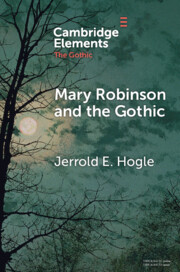Bibliography
Aguirre, Manuel, “Mary Robinson’s ‘The Haunted Beach’ and the Grammar of Gothic,” Neophilologus 98 (2014): 689–704.
Baudrillard, Jean, Symbolic Exchange and Death, trans. Iain Hamilton Grant (London: Sage, 1993).
Bolton, Betsy, “Romancing the Stone: ‘Perdita’ Robinson in Wordsworth’s London,” English Literary History 64: 3 (1997): 727–759.
Brewer, William D., “Copies, Protean Role-Players, and Sappho’s Shattered Form in Mary Robinson’s The False Friend,” European Romantic Review 22: 6 (2011): 785–800.
Brewer, William D., “The French Revolution as a Romance: Mary Robinson’s Hubert de Sevrac,” Papers on Language and Literature 42: 2 (2006): 115–149.
Castle, Terry, “The Spectralization of the Other in The Mysteries of Udolpho,” in Nussbaum, Felicity and Brown, Laura (eds.), The New Eighteenth Century: Theory, Politics, English Literature (New York: Methuen, 1987), pp. 231–253.
Chandler, James, An Archeology of Sympathy: The Sentimental Mode in Literature and Cinema (Chicago: University of Chicago Press, 2013).
Clery, Emma J., “Horace Walpole’s The Mysterious Mother and the Impossibility of Female Desire,” in Botting, Fred (ed.), Essays and Studies 2001: The Gothic (Cambridge: D.S. Brewer, 2002), pp. 23–46.
Clery, E. J., The Rise of Supernatural Fiction, 1762–1800 (Cambridge: Cambridge University Press, 1995).
Clery, E. J., and Miles, Robert (eds.), Gothic Documents: A Sourcebook, 1700–1820 (Manchester: Manchester University Press, 2000).
Close, Anne, “Notorious: Mary Robinson and the Gothic,” Gothic Studies 6: 2 (2004): 172–191.
Coleridge, Samuel Taylor, and Wordsworth, William, Lyrical Ballads 1798 and 1800, edited by Gamer, Michael and Porter, Dahlia (Peterborough, Ont: Broadview, 2008).
Cross, Ashley, Mary Robinson and the Genesis of Romanticism: Literary Dialogues and Debts, 1784–1821 (London: Routledge, 2017).
Curran, Stuart, “Mary Robinson’s Lyrical Tales in Context,” in Shiner, Carol and Hoefner, Joel (eds.), Revisioning Romanticism: British Women Writers, 1776–1837 (Philadelphia: University of Pennsylvania Press, 1994), pp. 17–35.
Freud, Sigmund, “Mourning and Melancholia,” in The Standard Edition of the Complete Psychological Works, ed. and trans. James Strachey et al. (London: Hogarth Press, 1953–1974), vol. 14, pp.243–258.
Frye, Roland Mushat, The Renaissance Hamlet: Issues and Responses in 1600 (Princeton: Princeton University Press, 1984).
Godwin, William, Caleb Williams, edited by Clemit, Pamela (Oxford: Oxford University Press, 2009).
Godwin, William, Enquiry Concerning Political Justice, edited by Kramnick, Isaac (Harmondsworth: Penguin, 1976).
Groom, Nick, The Gothic: A Very Short Introduction (Oxford: Oxford University Press, 2012).
Hogle, Jerrold E., “The Ghost of the Counterfeit in the Genesis of the Gothic,” in Smith, Allan Lloyd and Sage, Victor (eds.), Gothick Origins and Innovations (Amsterdam: Rodopi, 1994), pp. 23–33.
Hogle, Jerrold E., “The Gothic-Romantic Hybridity in Mary Robinson’s Lyrical Tales,” The European Legacy 24: 3–4 (2019): 24–34.
Lewis, Matthew Gregory, The Monk, edited by Macdonald, David L. and Scherf, Kathleen (Peterborough, Ont.: Broadview, 2004).
Locke, John, An Essay Concerning Human Understanding, edited by Nidditch, Peter H. (Oxford: Clarendon Press, 1979).
Longus, The Pastorals, or the Loves of Daphnis and Chloe: The Athenian Society Translation (Cambridge, Ontario: In parentheses, 2002).
Lyotard, Jean François, The Differend: Phrases in Dispute, translated by George, Van Den Abbeele (Minneapolis: University of Minnesota Press, 1988).
McGann, Jerome, The Poetics of Sensibility: A Revolution in Literary Style (Oxford: Clarendon, 1996).
Mellor, Anne K., “Mary Robinson and the Scripts of Female Sexuality,” in Coleman, Patrick, Lewis, Jayne Elizabeth, and Kowalik, Jill Anne (eds.), Representations of the Self from the Renaissance to Romanticism (Cambridge: Cambridge University Press, 2000), pp. 230–259.
Miles, Robert, Romantic Misfits (London: Palgrave Macmillan, 2008).
Morris, David B., “Gothic Sublimity,” New Literary History 16: 2 (1985): 299–219.
Poovey, Mary, “Ideology and ‘The Mysteries of Udolpho’,” Criticism 2: 4 (1979): 307–330.
Radcliffe, Ann, A Sicilian Romance, edited by Milbank, Alison (Oxford: Oxford University Press, 1993).
Radcliffe, Ann, The Italian, edited by Garber, Frederick and Clery, Emma J. (Oxford: Oxford University Press, 1998 a).
Radcliffe, Ann, The Mysteries of Udolpho, edited by Dobrée, Bonamy and Castle, Terry (Oxford: Oxford University Press, 1998 b).
Robinson, Mary, A Letter to the Women of England and The Natural Daughter, edited by Setzer, Sharon M. (Peterborough, Ont.: Broadview, 2003).
Robinson, Mary, Selected Poems, edited by Pascoe, Judith (Peterborough, Ont.: Broadview, 2000).
Russo, Stephanie, “History Repeating: Mothers, Daughters, and Incest in Mary Robinson’s Vancenza and The False Friend,” Tulsa Studies in Women’s Literature 37: 1 (2018): 67–90.
Shaffer, Julie, “Walsingham: Gender, Pain, Knowledge,” Women’s Writing 9: 1 (2002): 69–85.
Sedgwick, Eve Kosofsky, “The Character in the Veil: Imagery of the Surface in the Gothic Novel,” Publications of the Modern Language Association of America 96: 2 (1981): 255–270.
Setzer, Sharon M., “The Gothic Structure of Mary Robinson’s Memoirs,” in Stelzig, Eugene (ed.), Romantic Autobiography in England (Farnham: Ashgate, 2009), pp. 31–47.
Shakespeare, William, The Riverside Shakespeare, edited by Blakemore, G. Evans et al. (Boston: Houghton Mifflin, 1974).
Spenser, Edmund, Edmund Spenser’s Poetry, edited by Maclean, Hugh (New York: Norton, 1968).
Storch, Rudolf F., “Metaphors of Private Guilt and Social Rebellion in Godwin’s Caleb Williams,” English Literary History 34: 2 (1967): 188–207.
Taylor, Charles, A Secular Age (Cambridge, MA: Harvard University Press, 2007).
Townshend, Dale, Gothic Antiquity: History, Romance, and the Architectural Imagination, 1760–1840 (Oxford: Oxford University Press, 2019).
Ty, Eleanor, Empowering the Feminine: The Narratives of Mary Robinson, Jane West, and Amelia Opie, 1796–1812 (Toronto: University of Toronto Press, 1998).
Walpole, Horace, The Castle of Otranto and The Mysterious Mother, edited by Frank, Frederick S. (Peterborough, Ont.: Broadview, 2003).
Walpole, Horace, The Letters of Horace Walpole, 4 vols. (Dinslaken: Anboco, 2016). E-Book.
Wollstonecraft, Mary, A Vindication of the Rights of Woman, edited by Hagelman, Charles (New York: Norton, 1967).
Wollstonecraft, Mary, Maria and The Wrongs of Woman, edited by Kelly, Gary (Oxford: Oxford University Press, 1980).



